|
Founding
of the Women's Club
 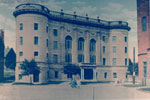 The
introduction of the Women's
Rights movement to Worcester was ushered in by a convention on December
24th, 1850 that focused primarily on the issue of expanding educational
opportunities to women, especially in the area of medicine, which at the
time stood as a "male monopolized" field. Thirty years later,
Worcester's next generation of women established the Worcester Woman's
Club on the day of the groundbreaking convention's anniversary. "The
Worcester Woman's Club was divided among committees on literature, history,
art, science, work and education, and social entertainment, as well as
the promotion of industrial training in public schools and public kindergartens"
(Worcester's Best 15). With no central meeting site to house the
organization, the women met within the private parlors of member's residences.
The women of this prestigious club were the wives and daughters of the
industrialists, most of them educated, but by no means freed from the
social and class constraints characteristic of the time. The
introduction of the Women's
Rights movement to Worcester was ushered in by a convention on December
24th, 1850 that focused primarily on the issue of expanding educational
opportunities to women, especially in the area of medicine, which at the
time stood as a "male monopolized" field. Thirty years later,
Worcester's next generation of women established the Worcester Woman's
Club on the day of the groundbreaking convention's anniversary. "The
Worcester Woman's Club was divided among committees on literature, history,
art, science, work and education, and social entertainment, as well as
the promotion of industrial training in public schools and public kindergartens"
(Worcester's Best 15). With no central meeting site to house the
organization, the women met within the private parlors of member's residences.
The women of this prestigious club were the wives and daughters of the
industrialists, most of them educated, but by no means freed from the
social and class constraints characteristic of the time.
From its foundation
in 1880 as a group of 22 women it had grown to 600 members with a waiting
list of more than 100 by the late 1890s (Worcester Magazine 160).
The Club clearly needed a permanent site within the community and was
given a lot from Stephen Salisbury III. The building's main hall was named
after Mr. Salisbury's grandmother Elizabeth Tuckerman, keeping the club
firmly rooted within the community of Worcester, particularly it's elite.
With a budget of over seventy thousand dollars, the Worcester Woman's
Club was well on its way to establishing what can arguably be considered
one of the city's finest cultural institutions.
Activities
of the Women's Club
 The
Woman's Club was never a "competitor" of Mechanics
Hall, which predated Tuckerman
Hall and set the standards for performance venues in Worcester. In
reality, the two truly complimented each other. The Woman's Club building
served as an enriching and artistic venue for a long and eclectic list
of programs which drew a wide range of attendees from the city. However,
both the size of the audiences (between 100 and 800, depending on which
hall was used) and the appeal of the events (a more family-oriented or
social theme can be detected in the canon of Tuckerman Hall events) differed
from those of Mechanics Hall. "Pop" historical performances
included a 1914 "Evening of Humor and Songs from the South."
Authentic medieval drama was represented by an enactment of the "Pilgrim
Chester Mystery Plays" (December 6, 1910). There were also frequent
musical concerts (often put on as fund-raisers for either the club itself
or one of the club's many community service projects) of classical favorites
like Bach, Wagner, Chopin, Liszt, and Mozart - and many of the solo musicians
for these concerts were female pianists, violinists, and singers. It is
easy to imagine that at a concert starring the Brown and Amherst Musical
Clubs of College Boys (May 19th, 1905), the stage was graced by the sons
and nephews of the ladies of the Club. The Woman's Club also hosted ballet
companies, chamber groups, and symphonies from elsewhere in the country
and the world. The
Woman's Club was never a "competitor" of Mechanics
Hall, which predated Tuckerman
Hall and set the standards for performance venues in Worcester. In
reality, the two truly complimented each other. The Woman's Club building
served as an enriching and artistic venue for a long and eclectic list
of programs which drew a wide range of attendees from the city. However,
both the size of the audiences (between 100 and 800, depending on which
hall was used) and the appeal of the events (a more family-oriented or
social theme can be detected in the canon of Tuckerman Hall events) differed
from those of Mechanics Hall. "Pop" historical performances
included a 1914 "Evening of Humor and Songs from the South."
Authentic medieval drama was represented by an enactment of the "Pilgrim
Chester Mystery Plays" (December 6, 1910). There were also frequent
musical concerts (often put on as fund-raisers for either the club itself
or one of the club's many community service projects) of classical favorites
like Bach, Wagner, Chopin, Liszt, and Mozart - and many of the solo musicians
for these concerts were female pianists, violinists, and singers. It is
easy to imagine that at a concert starring the Brown and Amherst Musical
Clubs of College Boys (May 19th, 1905), the stage was graced by the sons
and nephews of the ladies of the Club. The Woman's Club also hosted ballet
companies, chamber groups, and symphonies from elsewhere in the country
and the world.
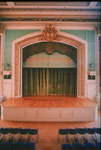 In
addition to these theatrical and musical events, the Woman's Club hosted
many interesting and worthwhile lectures, ranging from travelogues and
house-keeping advice for needy Worcester mothers, to political presentations
and scientific lectures. One of the most influential speakers, Fra Elbertus
(Roycroft Ideals lecture) was a
representative of the Arts and Crafts Movement of the turn of the century.
During the first half of the 20th century, the Hall boasted other greats
including Presidents Woodrow Wilson and John F. Kennedy. In
addition to these theatrical and musical events, the Woman's Club hosted
many interesting and worthwhile lectures, ranging from travelogues and
house-keeping advice for needy Worcester mothers, to political presentations
and scientific lectures. One of the most influential speakers, Fra Elbertus
(Roycroft Ideals lecture) was a
representative of the Arts and Crafts Movement of the turn of the century.
During the first half of the 20th century, the Hall boasted other greats
including Presidents Woodrow Wilson and John F. Kennedy.
However, although
extensive records exist of the performances that took place over the years
at Tuckerman Hall, (before its mid-century decline and recent resurrection
as home to the Central Massachusetts Symphony Orchestra and community
rental hall), we must not forget that it also served as headquarters for
an extremely active community group in the city of Worcester. In the days
before the New Deal, social welfare for the less-fortunate was left primarily
either to church charity or to private groups such as the Woman's Club.
One of the Club's largest projects, for example, provided summer vocational
school programs all day for hundreds of local children and adolescents,
relieving the stress of working parents. Perhaps the rise of governmental
aid was a factor in the Club's gradual loss of relevance to city life
in Worcester; however, during its heyday between 1900 and 1930, the Woman's
Club - its building, its members, and their activities - left a lasting
mark upon the city of Worcester.
The
Building and Architect
 The
building that housed the Worcester Woman's Club was erected in 1901-02
at the corner of Tuckerman and Salisbury Streets, immediately next to
the brand-new Worcester Art Museum. Both institutions were the beneficiaries
of the generosity of Stephen Salisbury III: the heir to the Salisbury
fortune donated a small and irregular corner of his property (left over
after the Museum, which he founded, opened its doors in 1898) to the Woman's
Club for their first clubhouse. This large and active group's need for
its own meeting space and function facilities was obvious to both its
members and, it would seem, to the rest of the city as well. The
building that housed the Worcester Woman's Club was erected in 1901-02
at the corner of Tuckerman and Salisbury Streets, immediately next to
the brand-new Worcester Art Museum. Both institutions were the beneficiaries
of the generosity of Stephen Salisbury III: the heir to the Salisbury
fortune donated a small and irregular corner of his property (left over
after the Museum, which he founded, opened its doors in 1898) to the Woman's
Club for their first clubhouse. This large and active group's need for
its own meeting space and function facilities was obvious to both its
members and, it would seem, to the rest of the city as well.
When the time came
for the selection of an architect, the leadership of the Club chose Josephine
Wright Chapman and her creative site-appropriate Federal Revival design.
"Worcester County people are proud of the fact that she is originally
a Fitchburg girl," stated an article in the November 1902 Worcester
Magazine (158). Chapman - a self-made woman who left home against
the wishes of her family, sold her jewels and clothing to survive, apprenticed
herself to the high-profile Boston architect Charles Blackall, and set
up her own firm by the 1890s - achieved recognition in her field when
she won the design for the New England building at the Pan-American Exposition
at Buffalo. She also designed in 1897 a student residence for Harvard
University, now Chapman Arms, Harvard Square, Cambridge MA.
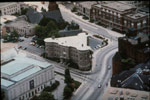 Chapman's
building not only solves the unique challenges of a triangular and steeply
sloped site, but also reflects in its style the mission of the Woman's
Club within the context of booming Gilded Age Worcester. According to
the Worcester Magazine, "the chief motive of the organization
has been not personal ease nor comfort, but the pushing of mankind up
to higher planes of living and doing." The Club's goals of self-improvement
for its membership as well as the social and cultural betterment of the
city (including Worcester's less-fortunate inhabitants) recall the ideals
and aspirations of the young Republic a century earlier, and make the
popular Federal Revival (or Colonial Revival, Georgian Revival, or Neo-Adamesque)
style of the turn of the century a perfect choice for the physical manifestation
of the institution. Chapman's
building not only solves the unique challenges of a triangular and steeply
sloped site, but also reflects in its style the mission of the Woman's
Club within the context of booming Gilded Age Worcester. According to
the Worcester Magazine, "the chief motive of the organization
has been not personal ease nor comfort, but the pushing of mankind up
to higher planes of living and doing." The Club's goals of self-improvement
for its membership as well as the social and cultural betterment of the
city (including Worcester's less-fortunate inhabitants) recall the ideals
and aspirations of the young Republic a century earlier, and make the
popular Federal Revival (or Colonial Revival, Georgian Revival, or Neo-Adamesque)
style of the turn of the century a perfect choice for the physical manifestation
of the institution.
Federal
Revival Style
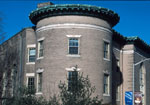 The
Federal Revival was popularized primarily through the work of the omni-present
American architectural firm McKim, Mead and White, beginning in the mid-1880s.
Along with the simultaneously popular Renaissance Revival, the Federal
Revival was supposed to "restore order to the architectural scene"
(Whiffen 160). The Federal Revival of course resurrects the accomplishments
of Federal-era architects such as Charles
Bulfinch, Samuel
McIntire and William
Thornton, who were in turn inspired by Classical sources such as Palladio,
and the mid-18th century English twist on the concept by the English brothers
Adam. The
Federal Revival was popularized primarily through the work of the omni-present
American architectural firm McKim, Mead and White, beginning in the mid-1880s.
Along with the simultaneously popular Renaissance Revival, the Federal
Revival was supposed to "restore order to the architectural scene"
(Whiffen 160). The Federal Revival of course resurrects the accomplishments
of Federal-era architects such as Charles
Bulfinch, Samuel
McIntire and William
Thornton, who were in turn inspired by Classical sources such as Palladio,
and the mid-18th century English twist on the concept by the English brothers
Adam.
"McKim,
Mead and White sought to create an urban environment out of the
common language of classicism which had been used to express ideals
of grandeur, stability and joy… Respecting local traditions and
materials, they tended to adopt different classical sources for different
categories of building: for public buildings they looked to the monuments
of ancient Rome or of the High Renaissance in Italy; for buildings with
less sober functions… they looked to the exuberant Renaissance
styles of Spain or northern Italy; and for educational or domestic buildings,
to the Georgian tradition of colonial America [for example see the Lathrop
House, Chicago 1892]" (Watkin 458).
The Woman's Club
building, the site of language, history, dance, and art classes, as well
as performances and lectures for both the members and the (paying) public,
clearly belongs to a region and era heavily influenced by the architectural
firm of America's industrial aristocracy. Its addition to Worcester's
north end, in close proximity to the Art Museum and the American Antiquarian
Society, asserts the city's cultural and commercial standing in New England
as a place of refined elegance equal to that of Manhattan or Boston. "No
public building in this city can vie with it in the richness and splendor
of its adornments, and far larger cities can show very little that surpass
them." (Worcester Magazine, Nov. 1902, 156)
Building
Description
 The
building itself (now known as Tuckerman Hall, although originally that
name referred only to the larger of its two performance/gathering halls)
fits perfectly on its unusual site. Although it is a nearly equilateral
triangle in form, the clever placement of protruding round towers at each
corner give it the appearance of a much larger square structure when viewed
from any of the three facades. Entrances are located on Tuckerman and
Salisbury Streets, the former designed to be the primary entrance to the
main hall (capacity 800 at the time of construction, 550 today), the latter
on a lower level to provide access to the smaller circular auditorium
known as Dean Hall (capacity 300 in 1902, 200 today) (Worcester Magazine
160). The three towers contain circular parlors for more intimate gatherings,
decorated in themes such as Dutch, Moorish, Renaissance, and Colonial. The
building itself (now known as Tuckerman Hall, although originally that
name referred only to the larger of its two performance/gathering halls)
fits perfectly on its unusual site. Although it is a nearly equilateral
triangle in form, the clever placement of protruding round towers at each
corner give it the appearance of a much larger square structure when viewed
from any of the three facades. Entrances are located on Tuckerman and
Salisbury Streets, the former designed to be the primary entrance to the
main hall (capacity 800 at the time of construction, 550 today), the latter
on a lower level to provide access to the smaller circular auditorium
known as Dean Hall (capacity 300 in 1902, 200 today) (Worcester Magazine
160). The three towers contain circular parlors for more intimate gatherings,
decorated in themes such as Dutch, Moorish, Renaissance, and Colonial.
 The
light brick exterior of the clubhouse presents a smooth symmetry, reflecting
the refined taste of the ladies of the organization. The building style
is identifiable as Federal Revival by its "mixing of stylistic details
taken from Georgian, Federal, or even Greek Revival sources and used together
on a single design" (Langhart 16). The exterior boasts classically-inspired
(thus Georgian- and Federal-inspired) details such as three-story attached
brick pilasters, two limestone entry porches supported by smooth columns
and crowned by balustrades, white molded courses above the first and fourth
stories, pressed metal panels with decorative floral and wreath designs,
rectangular double-hung sash windows, splayed lintels with centered keystone
blocks, and arched leaded fanlights above the tall central windows (three
on Salisbury Street, one on Tuckerman Street). A copper balustrade above
the cornice, recalling Federal sources, once finished the flat skyline
of the structure. The
light brick exterior of the clubhouse presents a smooth symmetry, reflecting
the refined taste of the ladies of the organization. The building style
is identifiable as Federal Revival by its "mixing of stylistic details
taken from Georgian, Federal, or even Greek Revival sources and used together
on a single design" (Langhart 16). The exterior boasts classically-inspired
(thus Georgian- and Federal-inspired) details such as three-story attached
brick pilasters, two limestone entry porches supported by smooth columns
and crowned by balustrades, white molded courses above the first and fourth
stories, pressed metal panels with decorative floral and wreath designs,
rectangular double-hung sash windows, splayed lintels with centered keystone
blocks, and arched leaded fanlights above the tall central windows (three
on Salisbury Street, one on Tuckerman Street). A copper balustrade above
the cornice, recalling Federal sources, once finished the flat skyline
of the structure.
 The
diverse shapes of the interior rooms - including circles and a triangle
- reveals the Federal influence, when varied geometric shapes such as
oval, ellipse, circle, and polygons, became stylish in more sophisticated
buildings (Langhart 4) (see the Octagon
in Washington, D.C. by William
Thornton, 1800 and Gore Place
in Waltham, Mass., associated with Charles
Bulfinch, 1806). The interior also demonstrates Federal inspiration
through its decoration, designed by the architect herself. The Adam brothers
popularized Classical and mythological details for interior decoration,
as exemplified in Syon
house; however, for a more direct source of these vivacious embellishments,
we can probably refer to Chapman's architectural trainer Clarence Blackall,
responsible for Boston's opulent theaters (including the Colonial, the
Wilbur, and the Wang Center). Intricate gilded floral and figural reliefs
accented the blues and greens of the wall. The
diverse shapes of the interior rooms - including circles and a triangle
- reveals the Federal influence, when varied geometric shapes such as
oval, ellipse, circle, and polygons, became stylish in more sophisticated
buildings (Langhart 4) (see the Octagon
in Washington, D.C. by William
Thornton, 1800 and Gore Place
in Waltham, Mass., associated with Charles
Bulfinch, 1806). The interior also demonstrates Federal inspiration
through its decoration, designed by the architect herself. The Adam brothers
popularized Classical and mythological details for interior decoration,
as exemplified in Syon
house; however, for a more direct source of these vivacious embellishments,
we can probably refer to Chapman's architectural trainer Clarence Blackall,
responsible for Boston's opulent theaters (including the Colonial, the
Wilbur, and the Wang Center). Intricate gilded floral and figural reliefs
accented the blues and greens of the wall.
The
Present
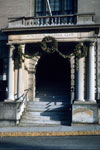 The
building's opening was held on the evening of October 6th, 1902 and as
reported by the Worcester Magazine, "No public building in this city
can vie with it in the richness and splendor of its adornments, and far
larger cities can show very little that surpasses them" (Worcester
Magazine 157). This "true gem" (Sunday Telegram L6) and
acoustic marvel was quite versatile, boasting a wide range of facilities
from the large Tuckerman Hall and smaller Dean Hall, to eight suites which
provided a more intimate venue. The Worcester Woman's Clubhouse was without
question a great success for its club, its architect, those who attended
functions and performances within, and for the city as a whole. Luckily,
it remains standing today, a venue for the Central Massachusetts Symphony
Orchestra and for community events like weddings musical performances,
corporate fund-raisers, etc. The Worcester Magazine's enthusiastic
reception of the building in 1902 still rings true today: "No traveler,
from near or far, will hesitate to pronounce the clubhouse not only unique,
but strikingly beautiful, a tribute alike to the woman who designed and
the women who accepted" (158). The
building's opening was held on the evening of October 6th, 1902 and as
reported by the Worcester Magazine, "No public building in this city
can vie with it in the richness and splendor of its adornments, and far
larger cities can show very little that surpasses them" (Worcester
Magazine 157). This "true gem" (Sunday Telegram L6) and
acoustic marvel was quite versatile, boasting a wide range of facilities
from the large Tuckerman Hall and smaller Dean Hall, to eight suites which
provided a more intimate venue. The Worcester Woman's Clubhouse was without
question a great success for its club, its architect, those who attended
functions and performances within, and for the city as a whole. Luckily,
it remains standing today, a venue for the Central Massachusetts Symphony
Orchestra and for community events like weddings musical performances,
corporate fund-raisers, etc. The Worcester Magazine's enthusiastic
reception of the building in 1902 still rings true today: "No traveler,
from near or far, will hesitate to pronounce the clubhouse not only unique,
but strikingly beautiful, a tribute alike to the woman who designed and
the women who accepted" (158).
Bibliography
Andrews, Wayne, Architecture,
Ambition, and Americans: A Social History of American Architecture
(Revised Edition). New York: The Free Press (Macmillan Publishing Co.),
1978.
Langhart, Nick, Antique Homes Guide to Styles: Domestic Architecture
of New England to 1920. Douglas Mass.: Antique Homes Magazine, 1999.
Knowlton, Elliot B. and Gibson-Quigley, Sandra (Editors), Worcester's
Best, 2nd Edition: A Guide to the City's Architectural Heritage. Worcester,
Mass.: Preservation Worcester, 1996.
Smith, G. E. Kidder, Source Book of American Architecture: 500 Notable
Buildings from the 10th Century to the Present. New York: Princeton
Architectural Press, 1996.
Sunday Telegram (no date listed) "Tuckerman Tales." [Worcester
Historical Museum].
Sunday Telegram (September 29, 2002) "Tuckerman Hall Celebrates
100 Years." L6.
Sunday Telegram (October 29, 2000) "Restored Tuckerman Hall:
Shining Tribute to Women."
Watkin, David, A History of Western Architecture, New York: Thames
and Hudson Inc., 1986.
Whiffen, Marcus and Koeper, Frederick, American Architecture, Volume
1: 1607-1860. Cambridge, Mass.: The MIT Press, 1981.
Whiffen, Marcus, A Guide to the Styles: American Architecture Since
1780. Cambridge, Mass.: The MIT Press, 1981.
Worcester Magazine, Vol. IV, No. 5 (November 1902): 156-162 and
185-188.
Worcester Magazine (October 3, 2002) Tuckerman Hall's Centennial
Celebration: A Crowning Achievement for Worcester Women."
Worcester Historical Museum Library.
|

